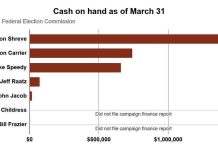A researcher who has analyzed the effect of historic preservation on cities large and small throughout the United States assured a Columbus audience that the benefits of pursuing preservation have far-reaching effects on the economy and quality of life.
Donovan Rypkema, principal of PlaceEconomics, a Washington-based economic development and consulting firm, was the keynote speaker for the Mayor’s Luncheon at the Preserving Historic Places Indiana Statewide Historic Preservation Conference at First Christian Church, 531 Fifth St.
In a fast-moving presentation filled with statistical research about the effects of historic preservation and historical districts on cities as big as New York City to those the size of Indianapolis, Rypkema shared findings with an audience of about 100, showing the effectiveness of historic preservation as a city revitalization strategy.
He acknowledged that the intersection of historic preservation and the economy is not a natural link. But he said his research shows that cities that have pursued historical preservation — such as through the nationally known Main Street program which came to Indiana in 1985, or other programs — find significant economic benefit above what the overall market might show without the preservation efforts.
[sc:text-divider text-divider-title=”Story continues below gallery” ]Click here to purchase photos from this gallery
Rypkema first went through four measurements used to determine the economic value of historic preservation in cities, including downtown revitalization, heritage tourism, jobs and income and property values.
He provided statistical proof from studies around the country that heritage tourism — which is traveling to experience places, artifacts and activities that authentically represent the history of a population or location — generates more money for cities than other tourist attractions, mainly because out-of-state visitors tend to spend more than tourists who are just visiting for a day.
Also, tourists in the heritage tourism category are much more likely to venture beyond traditional out-of-state destinations of New York, Florida and California, and instead travel into other states, he said.
Rypkema said historic districts, specifically those designated by a city as a local district, retain and increase property values even in times when the real estate market is flat or down. That means these local historic districts and their homes retain their value even when other homes throughout a city might be losing value, which affects the tax base of a city.
Columbus City Council President Frank Miller said he was interested in learning how Columbus can pursue getting more benefit out of its own downtown historic district.
“We can’t continue to sprawl out. We need to look at the internal area of the city and keep the inner city alive and vibrant,” he said. “I want to continue the conversation about this.”
Columbus Mayor Jim Lienhoop said the statistics showing the benefit of higher density of traditional historic districts means the costs of providing and upgrading services such as water, sewer and roads can be supported by the higher-density housing — something that is not the case in some lower-density outlying areas, which could be defined as sprawl.
“That would not have been readily understood without this presentation,” Lienhoop said. “With sprawl, there are higher costs for infrastructure and it costs more to provide sewer, water and other services per resident, because there are fewer residents,” he said.
But historic districts are also important as a way of preserving a city’s heritage, the mayor said.
“You always have to ask yourself, ‘Why is this city here?’ “ he said. “There’s always a story there. And that’s what we want to preserve.”
Local entrepreneur Tony Moravec, who has rehabilitated two historic Columbus buildings into attractive new uses — Zaharakos ice cream shop and the Upland Columbus Pump House, both downtown — said it was interesting to hear validation of the positive impact of historical preservation on a community.
Although tax abatements for historical preservation projects are sometimes debated, Moravec praised city officials for their use of the tool to help investors rehabilitate buildings that eventually generate more money and value in taxes for the city.
“The city is always willing to help in any way it can because they understand these projects will create a long-term tax generator,” Moravec said.
[sc:pullout-title pullout-title=”Where to learn more” ][sc:pullout-text-begin]
For more information about PlaceEconomics and Donovan Rypkema’s research, visit placeeconomics.com
[sc:pullout-text-end][sc:pullout-title pullout-title=”About the conference” ][sc:pullout-text-begin]
About 280 people registered for this year’s Preserving Historic Places conference in Columbus, which concludes today.
To learn more, visit indianalandmarks.org/preserving-historic-places-conference.
[sc:pullout-text-end]




